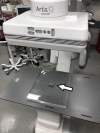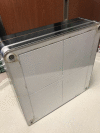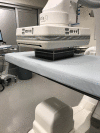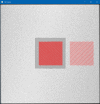Signal and contrast to noise ratio evaluation of fluoroscopic loops for interventional fluoroscope quality control
- PMID: 31593338
- PMCID: PMC6806477
- DOI: 10.1002/acm2.12734
Signal and contrast to noise ratio evaluation of fluoroscopic loops for interventional fluoroscope quality control
Abstract
Modern fluoroscopes pose a challenge for the clinical physicist for annual testing and continued upkeep. These fluoroscopes are critical to providing care to patients for complex interventions, and continue to evolve in automated image quality adjustments. Few tools in software or hardware currently exist to assist the physicist or technologist in gauging fluoroscope constancy or readiness for procedures. Many modalities such as mammography, computed tomography or even magnetic resonance imaging are much more evolved with respect to testing or quality control. In this work we sought to provide simple reproducible tools and methods for spot evaluating or continued quality testing of interventional fluoroscopes.
Keywords: CNR; SNR; fluoroscopy; quality control.
© 2019 The Authors. Journal of Applied Clinical Medical Physics published by Wiley Periodicals, Inc. on behalf of American Association of Physicists in Medicine.
Conflict of interest statement
The authors have no relevant conflict of interest.
Figures














References
-
- American College of Radiology- American Association of Physicsists in Medicine, Technical Standard For Diagnostic Medical Physics Performance Monitoring of Fluoroscopic Equipment; 2016.
-
- Medical Imaging and Technology Alliance, NEMA XR‐27-2013 . X‐ray Equipment for Interventional Procedures User Quality Control Mode, National Electrical Manufacturers Association with Ammendment 1 . http://www.medicalimaging.org. Accessed September 23, 2019.
-
- American College of Radiology, Computed Tomography Quality Control Manual; 2017.
-
- American College of Radiology, Digital Mammography Quality Control Manual; 2018.
-
- Tapiovaara MJ, Wagner RF. SNR and noise measurements for medical imaging: I. A practical approach to statistical decision theory. Phys Med Biol. 1993;38:71–92. - PubMed
Publication types
MeSH terms
LinkOut - more resources
Full Text Sources

